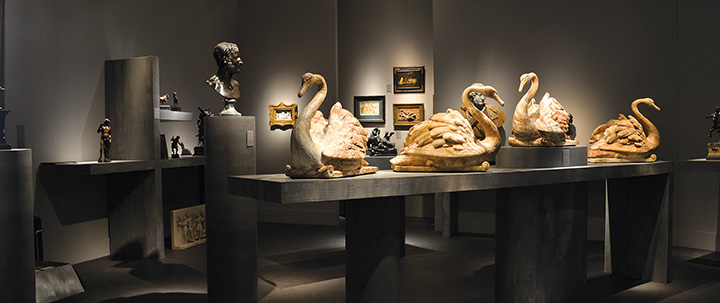By Marisa Bartolucci
Drama and scandal swirled around the opening of the twenty-eighth edition of the Biennale des Antiquaires. Less than a week before the celebrated fair opened, there was a thwarted terrorist attack near Notre Dame that only heightened anxiety about security, which was already tight, at the glorious glass-domed Grand Palais where the fair takes place, and made Parisians even gloomier about the year’s precipitous drop in tourism due to earlier attacks. On top of all that, antiques dealers were still reeling after the arrests of Laurent Kraemer, director of Galerie Kraemer, and Bill Pallot, a respected expert in eighteenth-century French furniture at the estimable gallery Didier Aaron, on suspicion of selling fake Louis XV chairs. Kraemer, whose gallery is the oldest family-run business in Paris, insisted on his ignorance of any fraud, but withdrew from the Biennale. The Syndicat National des Antiquaires, the sponsor of the Biennale, also suspended Didier Aaron from this year’s event, even though Hervé Aaron, the director of the gallery, had not been implicated. The Biennale announced, as well, that it was strengthening its vetting procedures and had hired a new team of eighty experts.

Offerings from Tomasso Brothers Fine Art of London included a group of four early seventeenth- century English alabaster swans attributed to sculptor Nicholas Stone. Courtesy of Tomasso Brothers Fine Art.
As if these developments were not agitating enough, the Biennale was itself in the process of a radical reinvention. Dominque Chevalier, president of the Syndicat, announced that the fair would heretofore become an annual event—with a new name to be announced later in the fall—and include a fresh mix of offerings. The Biennale has been under pressure in recent years to make changes because of new collecting trends and a more competitive fair environment, which is partly why Jean-Daniel Compain, a former director of FIAC and Paris Photo, was selected as the new general director. The big-name jewelry houses—which in recent editions had eclipsed the other booths with their grand, glittery displays—were gone, replaced by four smaller, more experimental, though equally luxe boutique brands, including Cindy Chao of Taiwan and Nirav Modi of Mumbai. While the gem vendors’ departure left space for more antiques dealers— their numbers virtually doubled to 120—there were, surprisingly, only seven specialists in eighteenth-century furnishings. Nevertheless, the old master paintings and drawings selection was expanded by sixteen dealers, as the Paris Tableau fair merged this year with the Biennale. Instead of having the different categories sectioned off by specialty, dealer booths of all stripes intermingled, making for surprising discoveries and unexpected convergences. A chic exhibition design by Nathalie Crinière, renowned for her many displays for the Fondation Pierre Bergé–Yves Saint Laurent, magnified the beauty of the architecture and brought clarity to the assorted offerings. The effect was nothing less than stunning.

The booth of Trebosc and van Lelyveld, a Paris gallery that specializes in European sculpture, was designed by the esteemed French architect and interior designer Jacques Garcia. Courtesy of Trebosc and van Lelyveld.
Interestingly, for this visitor at least, of all the offerings it was the antique statuary that held most allure. Paris-based Galerie Chenel was a favorite stand, specializing in archaeological objects, particularly those from ancient Rome. The gallery commissioned Mathieu Lehanneur, an immensely versatile young designer, to conceive the booth, and he framed the classical statuary within a compellingly minimalist environment to great effect. Also classical in nature, but with a charming twist, were twin terra-cotta sphinxes with a surprisingly sweet expression at the booth of Galerie Sismann. Gabriela Sismann believes these lovely creatures were made near Milan in the seventeenth century to decorate a loggia. Trebosc and van Lelyveld, a Paris-based gallery making its Biennale debut, provided an exceptional display of sculpture from the Renaissance to the early twentieth century. The acclaimed French

One of a pair of winsome terra-cotta sphinxes, made in northern Italy in the late seventeenth century, exhibited by Galerie Sismann of Paris. Courtesy of Galerie Sismann.
decorator Jacques Garcia transformed the booth into an evocative maze with flowing drapery that at once isolated and showcased each bust and sculpture. The London-based Tomasso Brothers, also new to the Biennale, provided another showstopper—an array of four graceful swans carved from English alabaster in the seventeenth century, probably by Nicholas Stone, a master stonemason and frequent collaborator of Inigo Jones. The creatures were not only beautiful but exceedingly rare, as the political and religious turmoil of that and the previous century had limited patronage for secular sculpture. Believed to have once adorned the fabled grotto at Jones’s magnificent Wilton House, the birds seemed an exceptional trophy, and something of a catch, at 950,000 euros.

